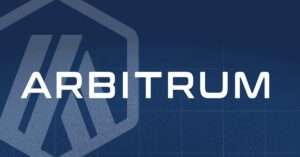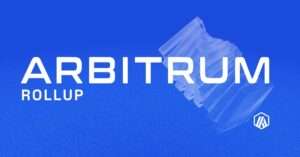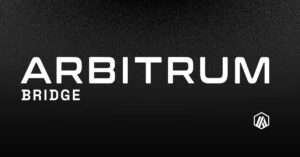Latest News
- SUI Price Analysis After Flipping Arbitrum On This Front
- Understanding Arbitrum’s Timeboost Priority Bidding and Converge RWA Chain
- Converge Blockchain: CEO Dormingo Reveals Next Step for Ethena and Securitinize’s Chain
- Arbitrum Launches Converge: A New Era for DeFi and RWAs
Current Price
The current price of ARB is $0.30133
Introduction
Arbitrum (ARB) has emerged as a notable Layer-2 scaling solution for Ethereum, addressing the pressing issues of transaction speed and gas fees through its innovative use of optimistic rollups.
This platform not only facilitates seamless integration of existing Ethereum applications but also positions itself as a key player in the domains of decentralized finance, non-fungible tokens, and gaming.
However, the landscape is not without its challenges, including reliance on Ethereum’s underlying infrastructure and rising competition.
Let’s dig deeper in this Arbitrum review.
Quick Overview
- Arbitrum is a Layer-2 scaling solution for Ethereum that enhances transaction speeds and reduces gas fees through optimistic rollups.
- It allows seamless migration of dApps from Ethereum, promoting interoperability within the ecosystem.
- The platform supports Ethereum’s native asset (ETH) and ERC-20 tokens, ensuring broad asset compatibility.
- Arbitrum’s governance model encourages community participation and aims to foster decentralization.
- The solution faces challenges, including reliance on Ethereum’s infrastructure and potential centralization risks in its governance model.
Overview of Arbitrum
Arbitrum is a prominent layer-2 scaling solution designed to enhance the performance and efficiency of the Ethereum network. By addressing the inherent limitations of Ethereum’s transaction throughput and high gas fees, Arbitrum seeks to facilitate a more scalable and user-friendly environment for decentralized applications (dApps) and smart contracts.
Utilizing a mechanism known as optimistic rollups, Arbitrum processes transactions off the Ethereum main chain, thereby reducing congestion and lowering costs. This approach allows for faster transaction confirmations while maintaining the security and decentralization that Ethereum is renowned for.
Furthermore, Arbitrum is compatible with existing Ethereum smart contracts, allowing developers to migrate their applications with minimal friction.
The architecture of Arbitrum promotes interoperability with Ethereum’s ecosystem, enabling seamless interaction between layer-1 and layer-2 solutions. Additionally, the protocol supports a wide array of decentralized finance (DeFi) applications, gaming, and other blockchain-based services.
How Arbitrum Works
To understand how Arbitrum operates, it is essential to examine its use of optimistic rollups, a key technology that underpins its functionality. Optimistic rollups enhance throughput and reduce transaction costs by processing transactions off-chain while retaining the security of the Ethereum mainnet. In this framework, transactions are bundled into batches and submitted to Ethereum, allowing for significant scalability.
The optimistic model assumes that transactions are valid by default, which expedites processing. Validators can challenge this assumption, initiating a dispute resolution mechanism if they suspect fraud. This system relies on a decentralized network of validators who monitor and verify transaction validity, ensuring integrity without the overhead of constant on-chain verification.
Additionally, Arbitrum utilizes a unique data availability solution that enhances efficiency. Instead of requiring all transaction data to be posted on-chain, Arbitrum allows only essential data to be submitted, minimizing congestion on the Ethereum network. This selective data posting is vital for maintaining low fees and high throughput.

Key Features of Arbitrum
Five key features distinguish Arbitrum in the landscape of layer-2 scaling solutions for Ethereum.
First, its use of optimistic rollups enables significant transaction throughput by batching transactions off-chain while maintaining the security of the Ethereum mainnet. This architecture allows for reduced gas fees and faster confirmation times, making it appealing for high-traffic applications.
Second, Arbitrum’s compatibility with existing Ethereum smart contracts is a notable advantage. Developers can easily migrate their decentralized applications (dApps) to the Arbitrum network with minimal adjustments, ensuring a smooth shift without extensive redevelopment.
Third, the platform employs a unique fraud-proof mechanism that incentivizes honest behavior among validators. This deters malicious activities and enhances the overall security of the network.
Fourth, Arbitrum supports Ethereum’s native asset, Ether (ETH), as well as ERC-20 tokens, thereby facilitating a seamless user experience for asset transfers and interactions.
Lastly, the governance model implemented by Arbitrum encourages community participation in decision-making processes, fostering a decentralized approach to platform evolution.
Collectively, these features position Arbitrum as a formidable contender in the domain of Ethereum scaling solutions.
Benefits of Using Arbitrum
The benefits of using Arbitrum are critical in addressing the limitations of traditional blockchain systems.
Enhanced transaction speeds and lower gas fees greatly improve user experience, while improved scalability solutions guarantee that the network can handle increased demand without compromising performance.
These advantages position Arbitrum as a compelling choice for users seeking efficiency and cost-effectiveness in their blockchain transactions.
Enhanced Transaction Speed
Frequently, users of blockchain networks encounter challenges related to transaction speed, which can hinder the efficiency of various applications. Arbitrum effectively addresses this issue by utilizing an innovative layer-2 scaling solution that enhances transaction throughput and reduces confirmation times. By processing transactions off-chain while maintaining security through Ethereum’s mainnet, Arbitrum notably accelerates the speed at which transactions are validated and finalized.
One of the key features of Arbitrum is its rollup technology, which aggregates multiple transactions into a single batch before submitting them to the Ethereum blockchain. This not only minimizes congestion on the main chain but also optimizes resource usage, allowing for a higher volume of transactions to be executed concurrently.
As a result, users experience quicker confirmations, which is especially beneficial for decentralized applications (dApps) requiring real-time interactions. Moreover, the enhanced transaction speed contributes to a smoother user experience, attracting more developers and users to the Arbitrum ecosystem.

Lower Gas Fees
One of the most significant advantages of utilizing Arbitrum for transactions is the substantial reduction in gas fees. This cost-effectiveness is particularly essential for users and developers who frequently engage in decentralized applications (dApps) and smart contracts on the Ethereum network.
By employing layer-2 scaling solutions, Arbitrum efficiently alleviates the burden of high transaction costs that often plague the Ethereum mainnet.
The lower gas fees offered by Arbitrum present several benefits:
- Increased Accessibility: More users can participate in the network without the deterrent of exorbitant fees.
- Enhanced Profitability for Developers: Reduced transaction costs allow developers to allocate resources more effectively, potentially increasing their profit margins.
- Encouragement of Microtransactions: Lower fees enable the viability of microtransactions, facilitating new business models and services that would be impractical on the Ethereum mainnet.
- Greater User Retention: A more economical transaction environment can lead to higher user satisfaction and loyalty, fostering a more vibrant ecosystem.
Improved Scalability Solutions
Leveraging advanced scaling solutions, Arbitrum greatly enhances the transaction capacity of the Ethereum network. By utilizing optimistic rollups, Arbitrum processes transactions off-chain while maintaining a secure connection to the Ethereum mainnet. This mechanism allows for the bundling of multiple transactions into a single one, considerably reducing the load on the Ethereum blockchain.
One of the primary benefits of Arbitrum’s architecture is its ability to achieve higher throughput without compromising security or decentralization. This results in faster confirmation times and improved user experiences, especially during periods of high network congestion. Consequently, developers can build and deploy applications with more confidence, knowing that Arbitrum can handle increased demand.
Furthermore, Arbitrum’s compatibility with existing Ethereum smart contracts allows for seamless integration, enabling developers to migrate their projects to the Arbitrum layer with minimal friction. This adaptability cultivates a more extensive ecosystem of decentralized applications (dApps), further driving user engagement and transaction volume.
Comparison With Other Solutions
When evaluating Arbitrum (ARB) in the context of layer 2 scaling solutions, it becomes essential to contemplate its unique features relative to other prominent platforms such as Optimism and Polygon. Each of these solutions addresses Ethereum’s scalability challenges, but they do so through distinct methodologies and architectural designs.
Arbitrum employs an innovative rollup technique that enhances transaction throughput while maintaining Ethereum’s security guarantees. In contrast, Optimism focuses on simplicity with its optimistic rollups, which allow for faster transactions but may introduce some latency in finality.
Meanwhile, Polygon offers a multifaceted approach, providing various scaling solutions that cater to different use cases, including sidechains and zk-rollups.
Key differences include:
- Transaction finality: Arbitrum and Optimism typically offer quicker finality compared to Polygon’s diverse models.
- Security model: Arbitrum guarantees high security through its reliance on Ethereum’s base layer, akin to Optimism.
- Ecosystem compatibility: Polygon boasts a wider array of tools and integrations, appealing to diverse developer needs.
- User experience: Arbitrum often provides lower fees and faster processing, enhancing the user experience in comparison to its counterparts.
Ethereum Layer 2’s Comparison Chart
Our expert team here at Trade Wise have researched the most popular Ethereum layer 2 protocols and created a comparison table so you can quickly see how they stack up against each other.
We collected this data in June 2024 so it may change over time.
This table contains all the data you need to make an informed comparison of how the most popular layer 2 blockchains perform and the strengths and weaknesses of each.
Trade Wise ETH Layer 2 Comparison Table
| Layer 2 | Tokens | Mainnet | Type | Focused on | Launch Year | TPS | Estimated Gas (USD) |
|---|---|---|---|---|---|---|---|
| Polygon | MATIC, POL | Ethereum | Sidechain, zk-rollups | DeFi, Web3, NFTs, dapps | 2017 | 65,000 | $0.0005 |
| Arbitrum | ARB | Ethereum | Optimistic rollups | DeFi, Web3, NFTs, dapps | 2021 | 40,000 | $0.10 |
| Optimism | OP | Ethereum | Optimistic rollups | DeFi, Web3, NFTs, dapps | 2021 | 2,000 | $0.20 |
| Metis | METIS | Ethereum | Hybrid rollups | DeFi, Web3, NFTs, dapps | 2021 | 4,000 | $0.03 |
| ImmutableX | IMX | Ethereum | Zk-rollups | Games, NFTs | 2018 | 9,000 | $0.002 |
| Mantle | MNT | Ethereum | Optimistic rollups | DeFi, Web3, NFTs, dapps | 2023 | 1,000 | $0.15 |
| Stacks | STX | Bitcoin | Parallel chain | Dapps, Ordinals | 2021 | 300 | $0.50 |
Impact on Ethereum Ecosystem
Arbitrum’s implementation of layer-2 scaling solutions greatly enhances the Ethereum ecosystem by addressing key scalability challenges.
By facilitating lower transaction costs, Arbitrum not only improves user accessibility but also encourages greater adoption of decentralized applications.
This dual impact positions Arbitrum as a critical player in the ongoing evolution of Ethereum’s infrastructure.
Scalability Enhancements
Enhancing scalability has become a critical objective within the Ethereum ecosystem, particularly as the demand for decentralized applications continues to surge. Arbitrum, as a layer-2 solution, plays a pivotal role in addressing these scalability challenges by allowing Ethereum to process a greater volume of transactions without compromising on security or decentralization.
The scalability enhancements provided by Arbitrum can be summarized through several key features:
- Rollup Technology: Arbitrum utilizes optimistic rollups, which aggregate multiple transactions into a single batch, considerably increasing throughput.
- Reduced Latency: By processing transactions off-chain, Arbitrum minimizes the time taken to confirm transactions, thereby enhancing user experience.
- Interoperability: Arbitrum is designed to seamlessly integrate with existing Ethereum infrastructure, allowing developers to easily migrate their dApps.
- Security Guarantees: The solution maintains Ethereum’s robust security model by relying on the underlying blockchain for dispute resolution.
These enhancements contribute to a more efficient Ethereum ecosystem, enabling developers to build and scale decentralized applications while addressing the inherent limitations of the Ethereum mainnet.
As Arbitrum continues to evolve, its impact on scalability will be a critical factor in Ethereum’s long-term success.

Lower Transaction Costs
The implementation of Arbitrum’s scalability enhancements directly correlates with a notable reduction in transaction costs for users within the Ethereum ecosystem. By utilizing a Layer 2 solution, Arbitrum processes transactions off-chain while maintaining the security of the Ethereum mainnet. This innovative approach alleviates network congestion, which has historically been a primary driver of high gas fees on Ethereum.
As transaction volumes increase, the cost of executing smart contracts and transferring assets often escalates, creating barriers for everyday users. Arbitrum addresses this issue by batching multiple transactions together, thereby minimizing the amount of data that needs to be recorded on the Ethereum blockchain. Consequently, users benefit from lower fees, making decentralized applications (dApps) more accessible.
Furthermore, the reduction in transaction costs encourages broader participation in the Ethereum ecosystem, fostering innovation and adoption. Startups and developers are more inclined to experiment with dApps, knowing that operating costs are notably lowered.
Ultimately, Arbitrum’s impact on transaction costs not only enhances user experience but also strengthens Ethereum’s position as a leading platform for decentralized finance (DeFi) and other blockchain-based applications.
Use Cases and Applications
A robust ecosystem of use cases and applications has emerged around Arbitrum, showcasing its potential to greatly improve the Ethereum experience. By leveraging the advantages of layer-2 scaling solutions, Arbitrum enhances transaction throughput and reduces latency, making it conducive for a variety of applications.
Key use cases include:
- Decentralized Finance (DeFi): Arbitrum enables faster and cheaper transactions for DeFi protocols, facilitating seamless trading, lending, and borrowing activities.
- Non-Fungible Tokens (NFTs): The platform supports NFT marketplaces, allowing users to mint, trade, and auction digital assets with lower fees and quicker confirmations.
- Gaming: Gamers can experience reduced lag and costs, which is essential for real-time interactions and microtransactions in blockchain-based games.
- Decentralized Autonomous Organizations (DAOs): Arbitrum provides the infrastructure for DAOs to operate efficiently, enabling governance activities that require quick consensus without incurring high transaction costs.
These applications not only enhance user engagement but also contribute to the overall scalability and functionality of the Ethereum network, making Arbitrum a pivotal player in the evolving blockchain landscape.
Challenges and Limitations
Several challenges and limitations accompany the adoption of Arbitrum, which must be addressed for its long-term viability. One primary concern is the reliance on Ethereum’s underlying infrastructure. Any scalability issues or network congestion within Ethereum could impact Arbitrum’s performance and user experience, potentially deterring users from adopting the solution.
Furthermore, while Arbitrum aims to enhance transaction throughput and reduce fees, the actual cost savings may not be substantial enough to attract users from competing layer-2 solutions or alternative platforms. This competitive landscape introduces the risk of fragmentation, as users may gravitate towards platforms offering better incentives or unique features.
Additionally, the complexity of bridging assets between Ethereum and Arbitrum can pose a barrier for less technical users, limiting broader adoption.
Security concerns also arise, particularly regarding the potential for exploits in the smart contracts that govern Arbitrum’s operations.
Finally, the governance model may face scrutiny, as the distribution of ARB tokens could lead to centralization risks, with a few holders exerting disproportionate influence over decision-making processes.
Addressing these challenges is essential for Arbitrum to establish itself as a sustainable layer-2 solution in the evolving blockchain ecosystem.
Future Prospects
Opportunities abound for Arbitrum as it navigates the rapidly evolving landscape of blockchain technology and layer-2 solutions. Its unique architecture and focus on scalability position it well to capitalize on the growing demand for efficient transaction processing and reduced costs.
Several key factors contribute to the promising future prospects of Arbitrum:
- Integration with Ethereum: As a layer-2 solution, Arbitrum enhances Ethereum’s capabilities, allowing for seamless interoperability that attracts developers and users alike.
- Developer Adoption: The platform’s user-friendly tools and documentation facilitate an increasing number of projects migrating to Arbitrum, fostering innovation and ecosystem growth.
- Institutional Interest: Growing interest from institutional investors and enterprises in blockchain technology suggests that solutions like Arbitrum could play a critical role in mainstream adoption.
- Community Engagement: A robust community backing can drive improvements and foster a sense of ownership, thereby increasing the long-term sustainability of the platform.
Investing in Arbitrum
Investing in Arbitrum requires a thorough analysis of its market potential and the various risk factors associated with it.
As a Layer 2 scaling solution for Ethereum, Arbitrum presents significant opportunities for growth, particularly in the domains of decentralized finance (DeFi) and non-fungible tokens (NFTs).
However, potential investors must also consider regulatory challenges, competition, and technological vulnerabilities that could impact the value of their investments.
Market Potential Analysis
The burgeoning landscape of decentralized finance (DeFi) presents a compelling case for the market potential of Arbitrum (ARB). As a leading Layer 2 solution on Ethereum, Arbitrum enhances transaction throughput and reduces gas fees, which are significant barriers for users and developers alike.
Its unique technology enables faster and more cost-effective transactions, positioning it favorably against other scaling solutions.
Several factors contribute to the optimistic market outlook for Arbitrum:
- Growing Adoption: Increasing DeFi projects and dApps are integrating with Arbitrum, expanding its ecosystem.
- Ethereum’s Dominance: As Ethereum continues to lead the smart contract platform space, Layer 2 solutions like Arbitrum benefit from its success and user base.
- Robust Infrastructure: The platform’s architecture supports complex transactions, attracting developers seeking scalability and efficiency.
- Strong Community Support: Arbitrum boasts an active community that fosters innovation and user engagement, essential for its sustained growth.
Risk Assessment Factors
While the market potential for Arbitrum (ARB) appears promising, it is essential to evaluate several risk assessment factors that could impact investors. One significant risk is regulatory uncertainty. As governments and regulatory bodies around the world formulate policies on cryptocurrencies, Arbitrum’s operations and tokenomics could be affected by sudden legal changes, which may devalue the asset.
Another risk stems from technological vulnerabilities. Being a layer 2 solution, Arbitrum relies on Ethereum’s security. However, any exploits or bugs within the underlying Ethereum network could jeopardize Arbitrum’s functionality and, consequently, investor confidence.
Market volatility is also a critical factor. The cryptocurrency sector is notorious for its price swings, and ARB is no exception. Investors must be prepared for potential losses during market downturns, which could be exacerbated by broader economic conditions.
Additionally, competition poses a threat. As Layer 2 solutions proliferate, Arbitrum faces challenges from established and emerging projects that may offer superior scalability or lower fees. This competitive landscape necessitates ongoing innovation to maintain market share.
Frequently Asked Questions
What Is the Origin of Arbitrum’s Development Team?
The development team of Arbitrum originated from Offchain Labs, a technology company founded by experienced professionals in blockchain and cryptography. Their expertise considerably contributed to the design and implementation of scalable solutions for Ethereum.
How Does Arbitrum Handle Network Security?
Network security in decentralized systems is typically managed through a combination of cryptographic protocols, consensus mechanisms, and periodic audits. Effective measures are essential to mitigate vulnerabilities, ensuring the integrity and reliability of transactions within the ecosystem.
Are There Any Upcoming Upgrades Planned for Arbitrum?
Upcoming upgrades for Arbitrum include enhancements aimed at improving scalability, transaction throughput, and user experience. These developments are designed to bolster network performance while maintaining security, positioning Arbitrum for increased adoption within the decentralized finance ecosystem.
What Are the Transaction Fees on Arbitrum?
Transaction fees on blockchain platforms typically vary based on network congestion and transaction complexity. Generally, Arbitrum offers lower fees compared to Ethereum, enhancing cost-effectiveness for users engaging in decentralized applications and smart contract execution.
How Does Arbitrum Support Developers and Projects?
The platform supports developers and projects through extensive documentation, robust SDKs, and a vibrant community. Additionally, it offers scalability solutions and incentivizes innovation, fostering an environment conducive to the development of decentralized applications.
Wrapping Up
To sum up, Arbitrum represents a significant advancement in Ethereum’s scalability through its innovative use of optimistic rollups.
Its ability to integrate seamlessly with existing Ethereum applications positions it favorably within the decentralized finance, NFT, and gaming sectors.
While challenges such as dependency on Ethereum’s infrastructure and competitive pressures exist, the platform’s community-driven governance and growing institutional interest suggest strong potential for future development and adoption.
This positions Arbitrum as a compelling solution within the evolving blockchain landscape.
